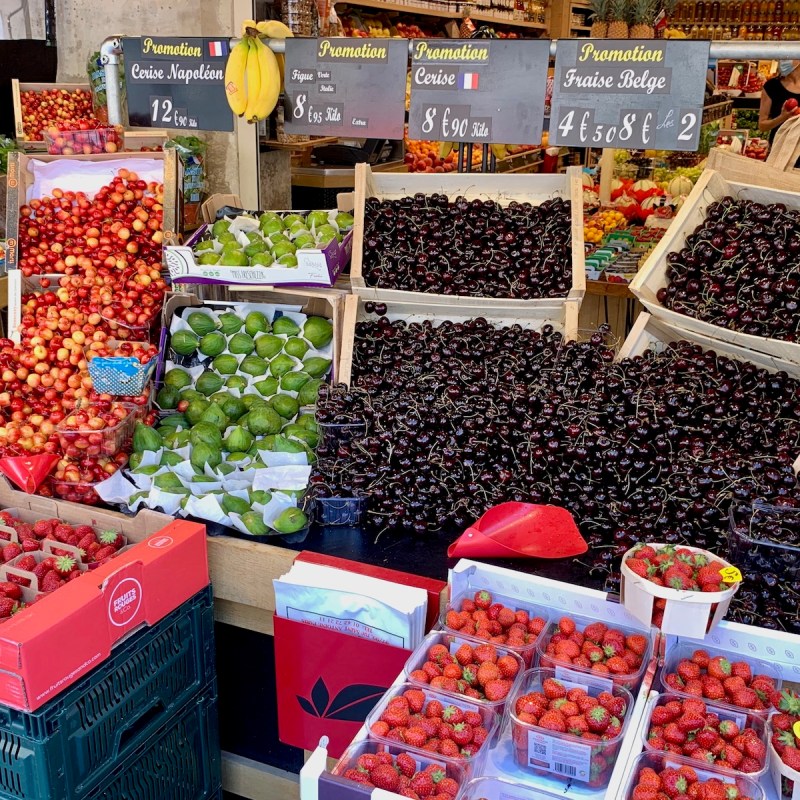
One of the top attractions in France is the incredible open-air, covered food markets around the country. In big cities, there are markets in every neighborhood, and in smaller towns and villages, there’s at least one main market. Not only do you get to experience the dizzying array of produce and food products, but you also get to have an experience watching how the locals shop for their food. We have compiled a list of the best food markets in France.
Videos by TravelAwaits
WARNING: Do not visit these if you are the least bit hungry!

1. Paris: Richard Lenoir/Bastille Market
The largest outdoor food market in Paris, Richard Lenoir/ Bastille Market stretches over five city blocks long, and you can buy everything from plums to pantyhose. It’s a combination food and flea market.
The crowds can be thick, but it’s still quite fun. Many of the sellers at the fruit stands are Middle Eastern, and they loudly boast in French and Arabic about their produce and will feed you samples of the ripest, seasonal fruits. Not only is there fresh produce, there’s seafood so fresh, it’s chilled just on ice, plus French cheeses such as Brie, Camembert, and goat, bread, prepared foods, honey, sea salt, and foie gras (duck liver pate). There are also ethnic food stalls with Middle Eastern, Chinese, Italian, and Israeli cuisine.
At the non-food stands, you can purchase beautiful cashmere, wool, and silk scarves, hand-made leather-bound diaries, kitchenware products, clothing, jewelry, shoes, children’s toys and games, and sneakers.
There’s no seating at the market but there are many cafes just across from it.
Pro Tip: The market is only open on Wednesday and Sunday from 8:30 a.m. to 1:30 p.m. It’s best to go before 10 a.m. to avoid the crowds. Sunday is the better day to visit because are more food stalls.
2. Versailles: Notre Dame Market
Before or after you visit the Versailles palace, you must visit the Notre Dame Market. About a 15- minute walk from the palace and close to the train station, the market is one of the best in France. Laid out in Notre Dame square, the indoor and outdoor market is a feast not only for the stomach but also for the eyes, with a cornucopia of food products that will dazzle even the most jaded foodie.
The four halls of the covered market contain butcher shops with prime cuts of beef, rotisserie chickens, hams, dried meat, and sausages, plus also seafood shops that have fresh oysters that they will shuck for you. There’s also a good selection of prepared foods such as paella, beef Bourgogne, quiches, and Italian and Greek specialties.
Outside there’s an abundance of fruits and vegetables, cheeses, olives and anchovies, international spices, mushrooms, and dried fruits.
A few blocks from the market is the lovely St. Cloud flower market.
The outside of Notre Dame market is open Tuesday, Friday, and Sunday from 7 a.m. to 2 p.m., and the indoor pavilions are open Tuesday to Saturday from 7 a.m. to 7:30 p.m. and Sunday from 7 a.m. to 2 p.m.
Pro Tip: Buy food at the market and have a picnic on the gorgeous grounds of the Versailles palace. Pick up cheeses, bread, and charcuterie, plus a bottle of wine, and have a feast. Alternatively, there are a number of food trucks with a big selection of plates to go.
3. Rennes: Lices Market
People from all over Normandy travel to this special market, the second largest in France, and I even have a chef friend who lives in Paris who sometimes takes the 90-minute train ride just to go to the market and come back.
The Lices Market is over 400 years old, and there are over 300 stalls selling the best foods the Normandy region has to offer. Local specialties include apples and by-products such as apple cider and Calvados, an apple-flavored liqueur; salted butter caramels; rich Pont-l’évêque cheese; butter; and authentic crepes and galettes prepared with buckwheat flour. Another delicious local treat is galette saucisse, a savory cake filled with sausage.
The Lices Market is only open on Saturdays from 7:30 a.m. to 1 p.m.
Pro Tip: Rennes is an easy day trip from Paris, just 90 minutes, and after the market, you can visit the beautiful, 75-acre Parc Thabor, roam the streets of the old quarter near rue Hoche, and marvel at the 13th-century half-timbered houses.

4. Lourmarin
One of the prettiest villages of the Luberon region in Provence is Lourmarin. Every Friday, the market takes over the center of the village, lined with plane trees, and extends for blocks on end.
The market is not just for food, almost half of it is for local crafts and artisanal products. Vendors offer fresh bouquets and sachets of the iconic Provence lavender; soaps scented with lavender, sage, and verbena; pottery, ceramics, tablecloths, placemats, and cloth napkins in traditional Provencal patterns; and hand-woven baskets.

Food products include Provencal olives and olive tapenade, honey, wine, jams and jellies, fruits and vegetables, bread and pastries, sausages, garlic, and herbs de Provence.
The Lourmarin market is open every Friday from 8 a.m. to 1 p.m.
Pro Tip: After the market, head into the main street of Lourmarin and have a coffee or drink at one of the numerous cafes.
5. Uzes: Place Aux Herbes
A charming village about 30 minutes from the city of Nimes, Uzes is in the Languedoc-Roussillon region. Plane trees surround the main square of town, Place aux Herbes, which is where the Wednesday and Saturday market operates. Known as one of the most beautiful markets in the south of France, the square also has a stone fountain in the middle and is surrounded by ancient buildings with covered passageways.
6. Nice: Cours Saleya Market
An almost endless row of pastel and colored striped awnings line the walkway of Cours Saleya in Old Nice. Under those awnings, you can find the tastiest Nicoiesian foods, fruits, and vegetables. Prepared foods include ratatouille, les Petits Farcis (roasted eggplant, peppers, tomatoes, and zucchini stuffed with ground beef, garlic, and breadcrumbs), and pan bagnat (tuna Niçoise on bread drizzled with olive oil). One popular stall has socca, which is a dry pancake made with crushed chickpeas and baked in a pizza oven. Niçoise olives, anchovies, olive oil, herbs de Provence in burlap sacks, and other spices, plus capers are just a short list of the wonderful food products for sale at the market.
The Cours Saleya Market is closed on Mondays but is open every other day — Tuesday through Saturday 6 p.m. to 5:30 p.m. and Sunday 6:30 a.m. to 1:30 p.m.
Pro Tip: There are also side markets for flowers, antiques, and crafts nearby.

7. Lyon: Les Halles De Lyon
Lyon is the other food capital of France, and food critics and foodies often say it’s superior to Paris. Paul Bocuse was the most famous and celebrated chef in France, and he paved the way for Lyon to become a major culinary destination. Besides his successful Michelin star restaurants, Bocuse expanded his reach and proudly added his name to the rebuilt Lyon food halls in 1971. In 2004 the market was refurbished and added more square footage. The enormous space now measures 140,00 square feet and spreads out over three floors. The 48 vendors are some of the most prestigious food purveyors in Lyon and have very high standards.
In addition to the usual produce, meat, and seafood stalls, there are fine chocolates, prepared foods for takeout, breads, pastries, truffles, wine, and cheeses. There are also three top notch restaurants: Chez Léon, Le Fer à Cheval, and Chez Les Gones. If you are adventurous, try some frog legs at Baba A Grenouille.
Les Halles de Lyon is open Monday to Saturday, 7 .a.m. to 7 p.m. and Sundays and holidays 7 a.m. to 1 p.m.
8. Bordeaux: Les Halles De Bacalan
This new and beautifully designed enclosed market is just across the street from the Cite du Vin, the interactive wine museum and center. Les Halles de Bacalan has 24 hand-selected merchants with superior and mostly artisanal products including meat and poultry, fish, chocolates and desserts, baked goods, wine, charcuterie, foie gras, truffles, and a stall with dried Iberian ham.
Les Halles de Bacalan is open 8 a.m. to 6 p.m. Monday to Saturday and Sunday 8 a.m. to 3 p.m.
Pro Tip: Admission to the Cite du Vin includes a glass of wine, so if you are drinking on an empty stomach, it’s convenient to pick up something to eat at the market.
Pro Tip
It’s best to bring your own tote or shopping bag. If you forget one, they’re sold at most markets. Get to the market on the early side, before 10 a.m. before the big crowds gather. Alternatively, some markets will sell off their produce and perishable items at a discount during the last 30 minutes before closing. Summertime in the smaller villages is usually the busiest time for the markets. Food makes a perfect gift to take home to friends and family, so pick up gourmet finds and pack them in your suitcase — just make sure you leave one or two for yourself.
